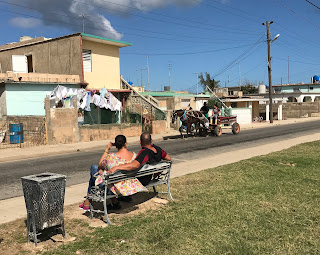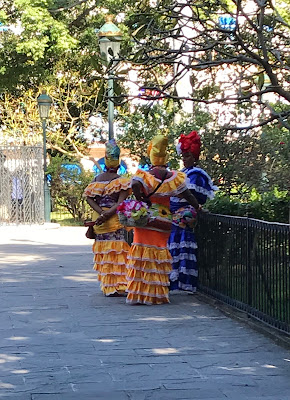One last dusty walk through Boca, dragging our rolling suitcases behind, and then a brief wait for the nickel bus to the Viazul staton in Varadero. Goodbye, sweet Boca! We had purchased our tickets days before. Good thing, too, because the station was mobbed with tourists attempting either to buy tickets or to check in.
We arrived in Varadero just under an hour early for our 2:30 departure. We had hoped to purchase as many tickets as needed for upcoming bus trips. A sign at the ticket counter said to check in. We had two tasks ahead of us that might require some Spanish, so Craig sat with our luggage and I joined the “ticket line,” a disorganized jumble of sweating bodies, all impatient, all confused. For at least forty-five minutes, we all rubbed elbows and sweaty forearms, eagerly awaiting contact with one of two harried Viazul agents. Clearly, nothing was happening quickly.
Finally, ten minutes before our bus was due to depart, I reached the head of the pack. For some reason —-ancient computer system, glitchy software, inadequate bandwidth?—- each task took forever. The frustrated but cheerful agent was only able to punch in three or four key strokes before the screen would freeze. This job obviously required a large measure of patience and persistence. Finally, a few more keystrokes and check in was accomplished. Next task: an attempted ticket purchase for our Vinales to Havana run in a few days.
Clickety clack chattered her long nails on the keyboard, patiently impatient. Boom! Four more key strokes, then nada. Clickety clack… Boom! A few more keystrokes on the grainy, antiquated screen. Clickety clack… Even the bus driver came to see what was taking so long. I was beginning to get antsy, even though I knew that Craig was loitering outside the bus to make sure I didn’t get left behind. Finally, I accomplished this one proactive ticket purchase and boarded the bus feeling great relief.
At some point during the ticketing ordeal, I realized that another ticket I had hoped to buy—-Cienfuegos to Vinales—- just does not exist. Viazul buses travel from Vinales to Cienfuegos, but not the other direction. Go figure… We had planned on three nights in Playa Giron and one night in Cienfuegos to get a peek at this lovely colonial city, but also to catch a bus to our next stop on the journey, Vinales. All accommodations had already been booked, and now I had purchased the tickets from Vinales back to Havana, without a clue how we would get to Vinales in the first place. Well, we would have plenty of time to think about this situation on the bus to Playa Giron. More on that in another post!
 |
| Our Viazul bus from a later run, from Havana to Vinales. |
 |
| No, it's not a car show; it's just Cuba. |
Viazul buses are clean and comfortable, if you can overlook the stray crumbled paper between seats and the abandoned beer bottle in the back seat pocket. I had a moment of trepidation at the padlocked bathroom at the back of the bus. No problem.
The bus stopped about halfway at a rest stop, a tourist watering hole with handicrafts for sale, bathrooms, cheap shots of rum (yes, we did), sandwiches, and a variety of drink options: juices, beer, mixed drinks, bottled water. Tourist prices, of course. We were glad we had filled our water bottles before leaving Boca de Camarioca.
Of course, no matter where you go you are likely to see lovely old classics like this one!
 |
| Craig awaiting his shot of "ron" |
 The view from the bus was fascinating: little pueblos, miles and miles of uncultivated land, and huge Soviet-era apartment buildings standing like strange monuments surrounded by fields of cultivated farmland. It was an entertaining parade of unexpected sights on and along the freeway.
The view from the bus was fascinating: little pueblos, miles and miles of uncultivated land, and huge Soviet-era apartment buildings standing like strange monuments surrounded by fields of cultivated farmland. It was an entertaining parade of unexpected sights on and along the freeway.After miles of tantalizing glimpses of the Bahia de Cochinos (Bay of Pigs), the bus rolled to a stop in little Playa Giron, currently not a site of United States interference, but rather a dive and snorkeling mecca, and also home to Museo Giron. We had no idea where our casa might be and had little desire to wander the hot streets of an unfamiliar town in search of our lodging. A pedicab at 1 CUC$ each sounded like a bargain. The driver was familiar with “Guanaba’s Nest,” so he loaded and strapped down our luggage and off he peddled. It turned out to be a mere quarter mile or so, but we were happy for the ride.
 |
| Taxi? Yes, please! |
 |
| Across from the bus stop: Museo Giron, complete with armored vehicles and aircraft on the front lawn |
 |
| Make a right at the intersection. Guanaba's Nest is a hundred feet ahead on the right! |
 “Guanaba’s Nest” looked bright and cheerful. Our congenial hosts, Yudy and Risber (Yes, he explained, his mom just made up his hame) welcomed us with wonderful hospitality, including coffee or a glass of juice. Judy showed us our air conditioned room and private bathroom, completed the necessary passport check for their documentation, handed over keys, and gave us plenty of helpful advice about snorkel and dive sites close by.
“Guanaba’s Nest” looked bright and cheerful. Our congenial hosts, Yudy and Risber (Yes, he explained, his mom just made up his hame) welcomed us with wonderful hospitality, including coffee or a glass of juice. Judy showed us our air conditioned room and private bathroom, completed the necessary passport check for their documentation, handed over keys, and gave us plenty of helpful advice about snorkel and dive sites close by.We had really arrived!
































































